
Ansys 2021 R2 is available for download on the Ansys Customer Portal.
If you need assistance with downloading or installing Ansys 2021 R2, please contact us at 919-321-6600 or support@mallett.com.
Learn more about Ansys 2021 R2 by viewing the information below or by joining one or more of the upcoming webinars.
Improvements in Ansys 2021 R2 products provide the power to explore early stage product design and complex system engineering from the nanometer scale of chip design to the mission level of aerospace and defense operating environments. Ansys’ industry-leading simulation solutions provide an open approach that streamlines engineering via simplified workflows, integrated data management and easy access to high-performance computing (HPC) power via the cloud.
Engineering exploration via simulation is virtually risk free because engineers are no longer bound to an expensive and time-consuming prototype-test-redesign cycle. New design ideas can be virtually evaluated in hours, not weeks, freeing up time to optimize the best design candidates or develop moonshot ideas that redefine markets. With access to nearly limitless computing via Ansys Cloud, engineers who use Ansys 2021 R2 products have the speed and flexibility to ask the “what-if” questions that lead to innovations in autonomous vehicles, chip design, mission-critical connectivity solutions and more sustainable travel via lightweight materials and electrification.
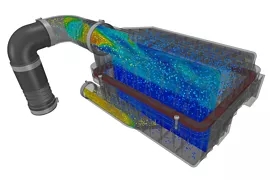
3D Design
Ansys 2021 R2 continues to expand simulation capabilities and ease of use for every engineer to unlock innovation and increase productivity throughout the product development process. In addition, every analyst can now benefit from Ansys Discovery’s geometry modeling workflows, groundbreaking Discovery Live physics and innovative user interface. The addition of Ansys associative CAD interfaces, history tracking and connection to Ansys Workbench makes Discovery an ideal complement to all other third-party tools and workflows within the Ansys portfolio.
Enhancements include:
- More engineering use cases: Idealized sliding contact for Live physics and porous media for high-fidelity physics, enabling fast, easy to use simulation of jointed assemblies and filtered flows.
- Ansys Workbench connectivity: Empowering analysts to do geometry preparation for simulation in Discovery, including materials selections and upfront simulation, with seamless transfer to Ansys Mechanical and Ansys Fluent.
- Connected geometry workflow: Associative CAD interfaces, history tracking and a constraint-based sketching automates Discovery’s modeling operations and provides a seamless workflow from CAD to any other Workbench-connected app.
- Workflow innovation: Saved scenes, physics condition suppression and connections to Ansys Granta Selector and Ansys Granta MI accelerate and automate the simulation workflow from setup through report generation.
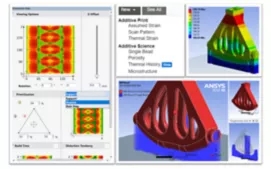
Additive Manufacturing
This release Additive Solutions enhances speed and workflows for users. Users will experience a significant improvements in accuracy across the Additive Solution products.
Ansys Additive Solutions Product Highlights for 2021R2:
- Faster solve times and improved user workflows for Additive Manufacturing users with improvements in Calibration Wizard and addition of Variable Layer Heights
- Increased accuracy and numerical consistency owing to changes to meshing defaults and improved robustness to Additive Manufacturing bond connections
- Significant speed improvements in Additive Manufacturing microstructure simulations by enabling users to apply more threads

Autonomous Vehicle Simulation
Ansys 2021 R2 continues to enhance the open architecture of autonomous vehicle (AV) solutions by connecting physics-based sensors to third-party driving simulators. This release includes new capabilities for sensor simulation and asset preparation, as well as an enriched library of assets. You can quickly and easily verify and validate AV sensor configurations, including perception and autonomous driving features, with the driving simulation tool of your choice.
With this latest release, headlamp designers gain new certification tests along with added capabilities for analysis, while our sensor modeling users benefit from significant productivity gains when parameterizing their models and their vehicle configurations. Radar experts are now able to model multi-modes and see micro-Doppler effects.
You will benefit from new NCAP Autonomous Emergency Braking (AEB) and Lane Support Systems (LSS) scenarios compliant with physics-based simulation in day and night driving conditions. The new APIs to control the sensor simulation and access raw sensor output will increase productivity through the support of your specific process and engineering tools.
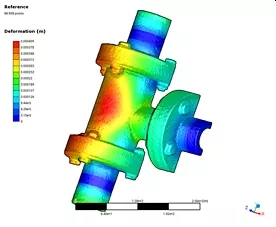
Digital Twin
The Ansys Twin Builder 2021R2 delivers powerful features in Twin Deployer, new capabilities for Reduced-Order Models (ROM) technology, integration into Rockwell Studio 5000 and Microsoft Azure as well as extended support for PTC ThingWorx and new capabilities for Modelica Librarie:
- Modelica Workflow Enhancements: New release makes easier to extend existing models & templates, includes the export for Win32 platform binaries (FMU) and workflow enhancements in cloning model & package creation.
- ROMs & ROM Viewer Enhancements: Static ROM Builder now supports field as input parameter. Add point probes to geometry for custom output and get an easier access to all ROMs in one place.
- Export, Deployment & Digital Twins: Build your dedicated library in Twin Deployer and Inspect 3D visualizations during simulation. Expanded ecosystem with new support for partner platforms Microsoft Azure Digital Twins and Rockwell Studio 5000 for twin export and Linux support for PTC ThingWorx.
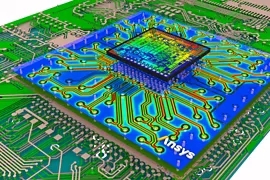
Electronics
Ansys 2021 R2 delivers groundbreaking technologies to address challenges in 3D IC, autonomy, 5G and electrification.
- Ansys introduces the Electronics Desktop Student version.
- Ansys HFSS Phi Plus meshing dramatically increases speed and capacity for 3D IC packaging simulation, including wire bonds.
- Ansys HFSS SBR+ enables efficient simulation of 3D dielectrics such as automotive bumper fascia and antenna radomes.
- Ansys SI Xplorer helps PCB designers to define stack-up and optimize via transitions.
- With EMA3D Cable’s mesh subgrid, engineers can define regions in the model where the mesh cell size can be different from the rest of the model.
- Ansys Icepak’s Joule heating analysis solves coupled electrothermal problems with static or transient excitations, while thermal ROM simplifies setup for variable flow rate problems. Icepak solver improvements enable 10 to 100X faster times for MCAD geometry processing and solving.
- Ansys Maxwell A-Φ solver enhances conductive EMC analysis for busbars, power electronics and PCBs.
- Ansys Maxwell 2D skew model enables 3D simulation accuracy of electrical machines at the speed of 2D.
- Multiphysics enhancements broaden applications of NVH in electromechanical devices and improve the thermal dependency response of permanent magnets.
- Introducing Ansys Nuhertz FilterSolutions — an RF and digital filter design, synthesis and optimization solution with Ansys HFSS integration.

Embedded Software
In Ansys 2021 R2, Ansys embedded software solutions enable even more development optimization and increased communication among team members.
Enhancements include:
- FACE Technical Standard conformance of Ansys ARINC 661 Cockpit Display System (CDS) Server, enabling engineers to quickly create and deploy advanced systems for next-generation cockpit displays, mission systems and operator controls.
- A simplified design and verification flow for automotive projects with enhanced AUTOSAR, A-SPICE and ISO 26262 support.
- A unique, qualified solution for embedded display software testing, covering the full V&V workflow from test execution on host, automated image comparison, automated model coverage measurement and test target harness generation.
- New qualifications allow Ansys to now be a one-stop-shop for safe software certification across all industries, for the highest safety integrity/assurance levels of DO-178C, ISO 26262, IEC 61508, EN 50128 standards.

Fluids
This release delivers features for improved workflows and more advanced simulations, including:
- Accurate and efficient simulation of bulk granular flows by coupling discrete element simulations to fluids and structures with Ansys Rocky.
- Up to 5X speed ups for high-speed flows to Mach 30 and above, with improved treatment of reaction sources in the density-based solver.
- Increased accuracy for hypersonic simulations with built-in thermodynamic non-equilibrium effects, NASA-9 coefficient material properties and partial slip-wall model for rarefied flows.
- A new built-in workflow for wall recession to model surface ablation.
- Embedded best practices in the automated mesh adaption setup for combustion and multiphase applications, resulting in cell count reductions of up to 70%.
- Combustion enhancements to help push decarbonization efforts with a new strained-FGM model for better NOx and CO predictions, as well as validation of recommended hydrogen concentrations and hydrogen blends.
- More detail added in your kinetics simulations with a new framework in Ansys Chemkin-Pro that now supports a liquid phase.
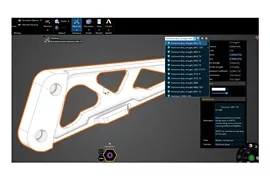
Materials
Our 2021 R2 release significantly improves the productivity for design, simulation and materials engineers by making trusted materials data quicker and easier to access.
Enhancements include:
- Bring materials into early-stage design with new integrations between Ansys Granta Selector, Ansys Granta MI Pro and Ansys Discovery
- Simplified management of your “gold-source” materials data by building targeted datasheets for design & simulation avoiding data duplication
- The latest material data to support industry-specific applications
- Enhanced material data in Ansys MDS to enhance simulation accuracy
- Easier access to difficult to find substances data with our new Chemwatch partnership
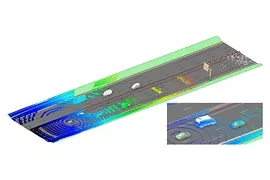
Optics and VR
In Ansys 2021 R2, Ansys Speos introduces powerful new modeling, visualization and lidar features, accelerating your time to market.
- Boost Your Optical Simulation with Productivity Enhancement: Manage and explore multiple Material Libraries and add libraries easily to your project for faster simulation set up.
- Simulation meshing is now 20x faster and local meshing up to 100x faster compared to previous versions.
- Visualize Your Optical Simulation with Speos Live Preview: Speos Live Preview provides you with a 100% true-to-life way to quickly view the same results as those produced with Speos CPU.
- Design Your Optical Simulation with Robust Design Geometries: Spread control on TIR Lens makes your optical lighting designs easier.
- Expanded Sensor Simulation Capabilities: New dynamic lidar capabilities enable object movement during lidar scanning simulations, allowing you to evaluate distortion on the raw signal. Scanning and rotating lidar sensor simulations are now compatible with Speos HPC and Ansys Cloud.
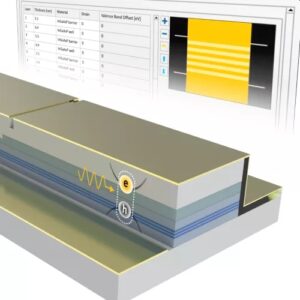
Photonics
The 2021 R2 release delivers powerful capabilities that speed time to result, improve simulation accuracy and expand interoperability with other Ansys products.
- New HPC and OS support includes the availability of Ansys Cloud Direct and updated support for SUSE and Ubuntu Linux.
- Integration with Ansys OptiSLang enables users to drive multiproduct simulation workflows.
- New capabilities for Ansys Lumerical MQW include support for excitons in gain calculation, a new user interface and additions to the material database.
- Ansys Lumerical STACK now includes support for thick layers, larger than the coherence length, for emissive display applications.
- A new workflow for Lumerical STACK and Ansys SPEOS for display applications from nano pixel design to human perception analysis.
- Improvements to Lumerical System Tools: the ability for Lumerical INTERCONNECT to import netlists from Tanner S-Edit, improvements to photonic compact models in CML Compiler, and Touchstone format support for optical simulation.
- Improvements to process-enabled custom component design include new layer builder support for electrical and thermal material models in foundry process files.
- Ansys Lumerical FEEM now includes anisotropic material support and a new PML boundary condition, allowing highly accurate loss calculations of leaky waveguides and fibers.
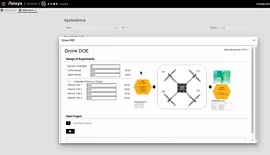
Platform
In Ansys 2021 R2, the platform product collection aims to brings tighter integrations with Ansys physics solvers to provide a much enhanced end user experience.
Enhancements include:
- Ansys optiSLang adds flexibility and accessibility with the new packaging model that includes premium and enterprise license options. In addition, optiSLang accelerates innovation through tighter integrations with Ansys Electronics Desktop and Ansys Workbench, allowing engineers to leverage the power of optiSLang directly from the solvers.
- Ansys Minerva enhances collaboration with custom dashboards that communicate relevant information efficiently among teams and contains a host of sleek, rich UI enhancements that greatly improve engineering productivity.
- Ansys LS-DYNA and LSTC are now Ansys Cloud-enabled, and a larger portfolio of Ansys products are available directly from the desktop application for HPC batch solves or directly in browser interactive sessions.

Safety Analysis
In Ansys 2021 R2, Ansys Safety Analysis dramatically decreases efforts with efficient application of safety, reliability and cybersecurity analysis methods and tight integrations to widely used engineering tools.
- Introducing Ansys Digital Safety Manager for the overall management of safety-related activities. Safety managers now have a single perspective on safety – beyond the individual project level.
- Reliability Block Diagrams (RBD) describe and analyze system reliability.
- The failure net is extended to show failure rates at malfunctions, as well as considering conditional probabilities.
- Support for cybersecurity goals according to ISO 21434.

Semiconductors
Ansys Semiconductor products lead the industry in power integrity, signal integrity, reliability and thermal signoff for all advanced process nodes down to 5nm and for advanced 3D multi-die system integrations.
Enhancements include:
- General availability of Ansys RedHawk-SC Electrothermal for comprehensive thermal, electrical and mechanical analysis of 2.5D/3D IC packages.
- New RedHawk-SC flow for finding and analyzing the activity vectors that give rise to the worst-case timing impact of dynamic IR drop.
- Advanced Power Diagnostics in RedHawk-SC for thorough debugging of dynamic voltage drop (DVD) issues in even the largest chip designs.
- Introducing Ansys Totem-SC, Ansys PathFinder-SC and Ansys PowerArtist-SC: These upgraded products are all based on the SeaScape technology and infrastructure that brings big-data elastic compute and native cloud enablement to these workflows.
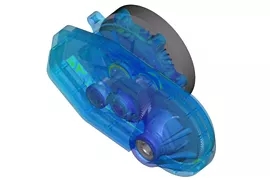
Sound Simulation (Acoustics)
Ansys 2021 R2 integrates additional products to ensure a smooth transfer of data for further acoustic simulations. It also features enhancements to VRXPERIENCE Sound for better sound design:
- For users concerned with NVH, Ansys Motion and Ansys VRXPERIENCE Sound integration allows drag-and-drop linking in Workbench between a harmonic acoustics system and the results of a multi-body dynamics analysis within Ansys Mechanical.
- Direct access to Ansys Fluent, Ansys Mechanical and other Ansys products with the Ansys VRXPERIENCE Sound SAS in the Ansys Unified Installer makes it easy to improve the acoustic performance and sound quality of an e-motor or fan.
- Advances in the acoustics solver technology in Ansys LS-DYNA and the transient acoustics workflow in Ansys Mechanical enables engineers to handle glass wool materials in cabin acoustics simulations and improve workflow efficiency.
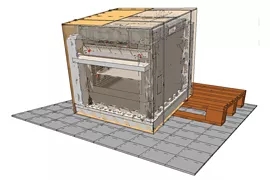
Structures
In 2021 R2, Structures products continue to deliver new features that enable flexibility, robustness and efficiency. The integration of products through Ansys Workbench enables users to leverage additional technology to broaden their scope of simulation.
Enhancements include:
- Ansys Sherlock integration with Ansys LS-DYNA through a single-click automated workflow in Workbench that rapidly creates meshed models for drop-test simulations in LS-DYNA, amongst other analysis types.
- Increased exposure of LS-DYNA technologies in Ansys Mechanical including Smooth Particle Hydrodynamics (SPH), Arbitrary Lagrangian Eulerian (ALE) and implicit/explicit solutions that enable workflows such as pre-stress loading and restarts for drop-test simulations.
- Streamlined multistage analysis with Ansys Mechanical offers differing cyclic symmetry sector counts in the same model, delivering tremendous time saving by reducing the model size and cutting the run time by up to 50X.

